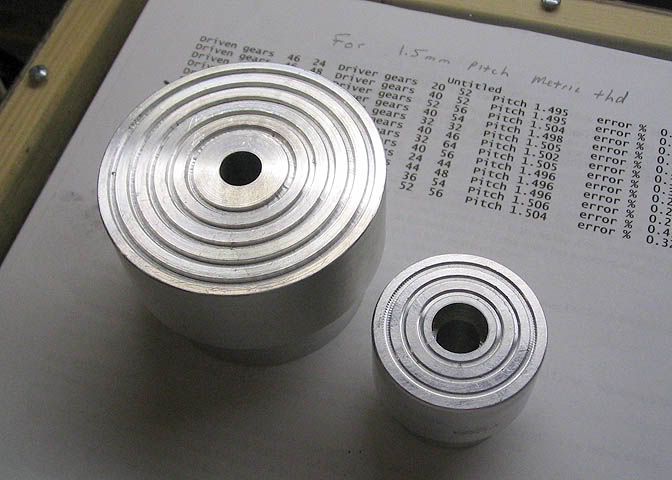Marv is certainly correct as usual (don't you just loathe guys like that :big

in his statement regarding an elipse. Of course had I set the angle of the mill head over more acutely I would have ended up with a more dished cross section but as the only requirement for clearance in this case was .125" in the center, I was lazy cheated and did not follow the drawings exactly. ;D The next most logical parts to be made were the bearing standards and caps. First it was a matter of sizing and squaring the aluminum pieces before proceeding to the lathe as can be seen here. The brass bar is used to assist the movable jaw of the vise to better apply pressure where it is needed most, in the center of the jaws and not toward the base as the jaw has a tendency to tilt when tightening up. I milled both pieces as a set to insure identical sizing.

I really admire the overall lines of this engine as it seems to possess more of a castings based model appearance rather than one made from barstock (even though this one is) but I did not particularly care for the squarish looks of the standards used in the original build and set off on my own to try and rectify that inconsequential problem. A few weeks ago, there was a thread/discussion regarding the usage of cyanoacrylate (super glue) as a means of holding odd shaped parts while machining. This is the method that I used to accomplish what I wanted to do though it was not without its faults and I will caution those that attempt to use these products in this manner to display and exercise extreme care in doing so. Proper eye protection should be worn at all times goes without saying. In my 'extras' box, I had a couple of disc brake, caliper pistons, that I had been wanting to use for a while and figured this would be the time. These pieces of steel are of a very good grade and once the chrome plating was cut through the base metal was a joy to work. This would serve as a known flat surface to which I used the adhesive, which happens to be a Loctite product, to mount the blanks to. I know what some of you are thinking and I have to agree but again, I had this vision and was determined to follow it through to its completion.

I had center popped the location of what would ultimately become the center of the crankshaft and used the dead center in the tailstock to position and hold the blanks to the surface of the caliper puck. A swabbing down with Isopropyl alcohol removed any traces of oil from its surface and I did not apply any activator although I do not think it would hurt anything.
After a 24hr. period had elapsed, which I figured was a good length of time for the adhesive to cure I again incorporated the use of that dead center in the tailstock and a small-ish slug of aluminum to assist in holding the blank firmly in place. The diameter of the slug had been turned to the diameter of the shoulder called out for and was used as a lazy man's guide to final dimension. After roughing out the piece I switched to a .125" cutter that I had ground a radius on and used it to do the final profiling, that is to eliminate the 90* junction that I did not care for.
Now then, I need to pause here a moment and relate to you all the first "OH S**T" :fan: moment that I encountered so far. In taking the next to last final cut to clean up the piece, it came off the backplate.



So, I had to start over again by laying out the piece anew and used my wiggler setup (the one I used to center the cylinder bore and water hopper cuts) to realign it back to true and perform the last cut.
OK, no harm, no foul, a minor setback and off I went to do the other side. With that out of the way I was feeling good again and was back in the "so far, so good mode once again. 8)
That is until I went to begin getting them squared up and mounted to the base. Did you catch it?
To myself I was muttering Hey STUPID!!!! There are supposed to be a "L" and "R" part, yeah you know the same piece but MIRRORED. :-[ :-[


th_wtf1 th_bs
Yeah, yeah, one little mistake. You know I was on autopilot, I knew full well about the parts being handed and did the layout with that very thing in mind and I STILL made two of the same piece. What a mahroo! :big:
Here is the replacement piece being final faced and the world was once again back in balance.
Now if I had this to do over and I possessed a rotary table (why don't I own one anyway ???) I would mount the parts on it and use a ball end cutter in the mill to perform this step, it would be a whole lot easier than what I did but I got the job at hand done. One could argue that I could have gripped the part in a four jaw chuck as well but again, I "had a vision". Man I hope I don't get many more of those ;D
BC1
Jim






























